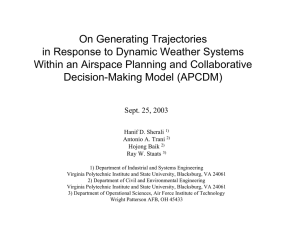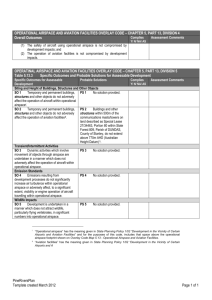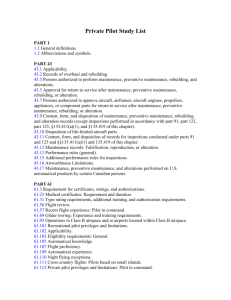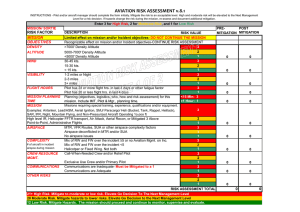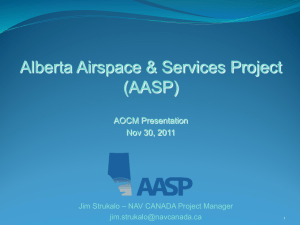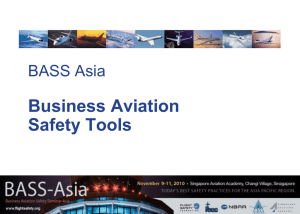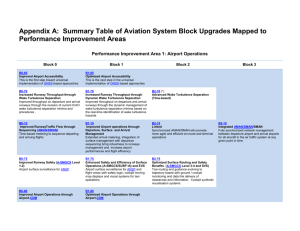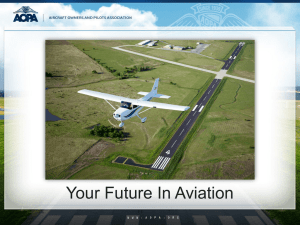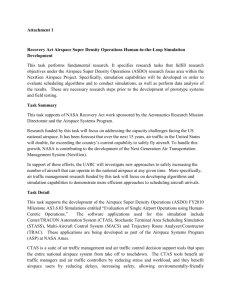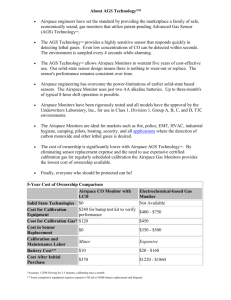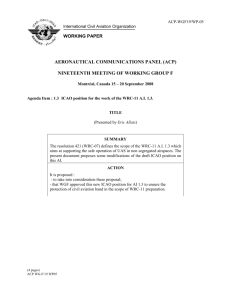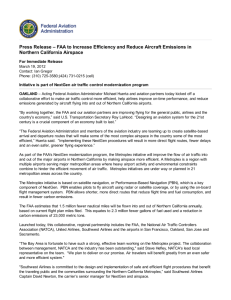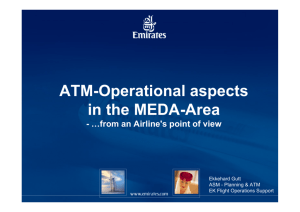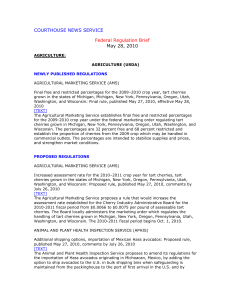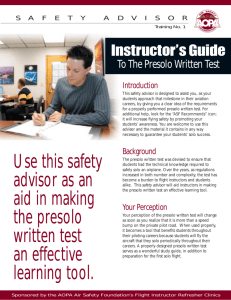UNIT CODE AVIY5022 Unit Title Manage traffic flow
advertisement
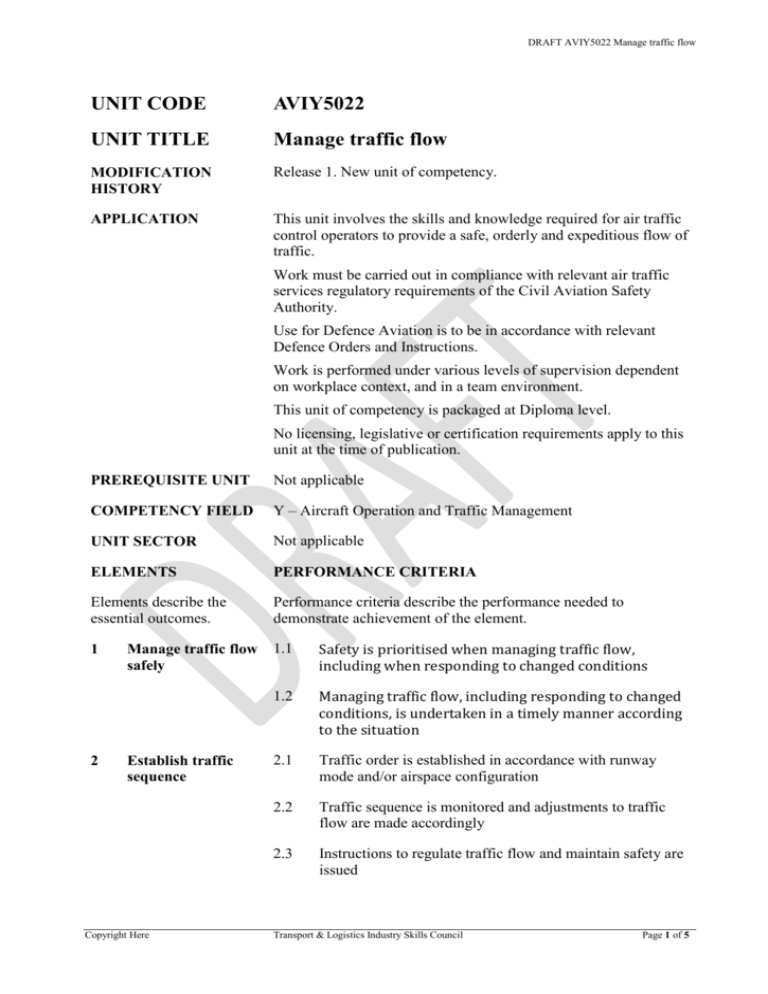
DRAFT AVIY5022 Manage traffic flow UNIT CODE AVIY5022 UNIT TITLE Manage traffic flow MODIFICATION HISTORY Release 1. New unit of competency. APPLICATION This unit involves the skills and knowledge required for air traffic control operators to provide a safe, orderly and expeditious flow of traffic. Work must be carried out in compliance with relevant air traffic services regulatory requirements of the Civil Aviation Safety Authority. Use for Defence Aviation is to be in accordance with relevant Defence Orders and Instructions. Work is performed under various levels of supervision dependent on workplace context, and in a team environment. This unit of competency is packaged at Diploma level. No licensing, legislative or certification requirements apply to this unit at the time of publication. PREREQUISITE UNIT Not applicable COMPETENCY FIELD Y – Aircraft Operation and Traffic Management UNIT SECTOR Not applicable ELEMENTS PERFORMANCE CRITERIA Elements describe the essential outcomes. Performance criteria describe the performance needed to demonstrate achievement of the element. 1 1.1 Safety is prioritised when managing traffic flow, including when responding to changed conditions 1.2 Managing traffic flow, including responding to changed conditions, is undertaken in a timely manner according to the situation 2.1 Traffic order is established in accordance with runway mode and/or airspace configuration 2.2 Traffic sequence is monitored and adjustments to traffic flow are made accordingly 2.3 Instructions to regulate traffic flow and maintain safety are issued 2 Manage traffic flow safely Establish traffic sequence © Copyright Here Transport & Logistics Industry Skills Council Page 1 of 5 DRAFT AVIY5022 Manage traffic flow 3 Provide traffic flow adjustments 3.1 Circumstances where delaying actions are necessary, and their causes are accurately identified 3.2 Air traffic clearances are withheld or instructions are imposed to achieve the necessary delay 3.3 Delaying actions are cancelled or relaxed when suitable and instructions are issued for onwards flight FOUNDATION SKILLS This section describes those language, literacy, numeracy and employment skills that are essential to performance. Foundation skills essential to performance are explicit in the performance criteria of this unit of competency. RANGE OF CONDITIONS Specifies different work environments and conditions that may affect performance. Essential operating conditions that may be present (depending on the work situation, needs of the candidate, accessibility of the item, and local industry and regional contexts) are included. Range is restricted to essential operating conditions and any other variables essential to the work environment. Operations may be conducted: by day and night in variable weather conditions Air Traffic Flow Management (ATFM) is established: to support ATC in ensuring an optimum flow of air traffic to, from, through or within defined areas during times when demand or expected demand exceeds the capacity of the system. Managing the traffic flow in this unit of competency is part of a control service and is not a discrete ATFM service UNIT MAPPING INFORMATION This unit is equivalent to AVIY5022B Manage traffic flow. LINKS AVI Aviation Training Package Companion Volume Implementation Guide at: http://tlisc.org.au/trainingpackages/aviation-training/. Page 2 of 5 Transport & Logistics Industry Skills Council Copyright Here DRAFT AVIY5022 Manage traffic flow TITLE Assessment Requirements for AVIY5022 Manage traffic flow PERFORMANCE EVIDENCE Evidence required to demonstrate competence in this unit must be relevant to and satisfy all of the requirements of the elements and performance criteria on at least one occasion and include: KNOWLEDGE EVIDENCE © Copyright Here adhering to procedures adjusting the routing and tracking of aircraft advising aircraft of delays allocating attention according to demand and constantly switch between: managing the Human-machine Interface or equipment use; managing communications; and managing traffic applying reasoning and decision making to airspace and flight path scenarios communicating effectively with others when managing traffic flow conducting the holding of aircraft and onwards processing formulating and issue onwards airways clearances, conditional clearances and clearance limits identifying and applying precautions and required action to minimise, control or eliminate hazards that may exist when managing traffic flow implementing contingency plans for unexpected events that arise when managing traffic flow prioritising tasks and managing workload projecting and planning airspace, traffic and flight path scenarios Evidence required to demonstrate competence in this unit must be relevant to and satisfy all of the requirements of the elements and performance criteria and include knowledge of: aerodrome runway combinations and traffic requirements air traffic clearances to hold, delay, limit and continue flight aircraft performance characteristics airspace geography and topography airspace, route structures and procedures used to assist strategic air traffic flow management area of radar coverage classification and special use airspace Transport & Logistics Industry Skills Council Page 3 of 5 DRAFT AVIY5022 Manage traffic flow ASSESSMENT CONDITIONS conditional air traffic clearance contingency plans for unexpected events that arise when managing traffic flow, including reduced facilities and degraded systems interpret airspace charts, maps and approach to land procedures including holding patterns interpret meteorological data non-published aircraft holding techniques principles of air traffic control relevant sections of regulatory and operational documentation roles and responsibilities for managing the air traffic flow safety hazards and risks that exist when managing air traffic and related risk control procedures and precautions systems and tools used for air traffic flow management traffic management techniques understand the reporting procedure in accordance with regulatory requirements and workplace procedures Assessors must satisfy National Vocational Education and Training Regulator (NVR)/Australian Quality Training Framework (AQTF) assessor requirements. Assessment processes and techniques must be appropriate to the language, literacy and numeracy requirements of the work being performed and the needs of the candidate. Resources for assessment include: a range of relevant exercises, case studies and/or other simulated practical and knowledge assessment, and/or access to an appropriate range of relevant operational situations in the workplace In operational and/or simulated assessment environments, access is required to: relevant and appropriate materials and equipment, and applicable documentation including workplace procedures, regulations, codes of practice and operation manuals Assessment of knowledge must be conducted. Practical assessment must occur: Page 4 of 5 through activities in an appropriately simulated environment and/or at a registered training organisation and/or in an appropriate range of situations in the workplace Transport & Logistics Industry Skills Council Copyright Here DRAFT AVIY5022 Manage traffic flow LINKS © Copyright Here AVI Aviation Training Package Companion Volume Implementation Guide at: http://tlisc.org.au/trainingpackages/aviation-training/. Transport & Logistics Industry Skills Council Page 5 of 5

